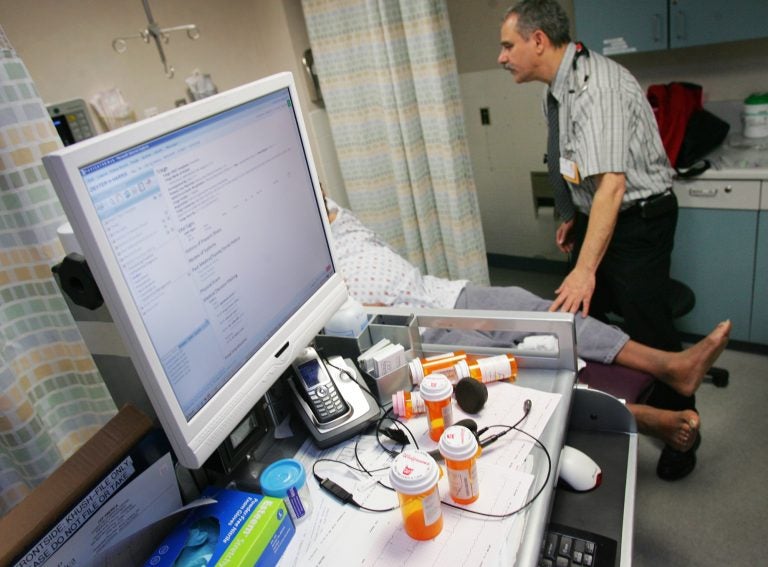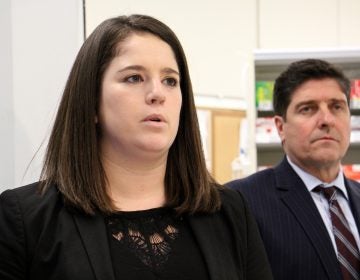Opioid prescription database helps Pa. doctors find at-risk patients
The prescription drug monitoring program has led to a 20 percent drop in opioid prescriptions in Pennsylvania, according to the state health department.

In this Feb. 23, 2010 photo, Dr. Jacob Khushigian checks on a patient who had overdosed with his portable computer data base shown in a Kaweah Delta Emergency Room in Visalia, Calif. (Gary Kazanjian/AP Photo)
In the year since Pennsylvania Gov. Tom Wolf signed an opioid disaster declaration, the state has worked to improve its database showing patients’ history of opioid prescriptions in an effort to help doctors and pharmacists decide if a patient is at risk for misuse.
For example, the prescription drug monitoring program or PDMP shows when a patient has seen many different doctors and gotten multiple prescriptions filled in a short period of time, indicating the patient might be “doctor shopping.” Physicians can use that information to avoid prescribing the patient more opioids for pain and instead refer them to treatment for opioid use disorder.
While research on the success of PDMPs nationwide is mixed, the PDMP has led to a 20 percent drop in opioid prescriptions in Pennsylvania, according to the state’s health department.
But Dr. Kit Delgado at the University of Pennsylvania’s Emergency Department says it can work the other way, too.
Often, when a patient is in acute pain, a doctor may think that an opioid prescription is the appropriate course of treatment. But the physician may hesitate to write that prescription if he or she believes there could be any risk for misuse. With the PDMP, Delgado said doctors can feel more comfortable writing the prescription with a clear conscience.
“We can consult the system and determine that they have not previously abused opioids, or have concerning patterns, and then feel more confident in writing them a prescription,” he said.
Delgado believes changes to the program since the statewide opioid emergency declaration last January have improved the quality of care his patients have received.
First, the PDMP was integrated into standard electronic medical records, meaning doctors and pharmacists can access a patient’s complete history with the click of a button, instead of having to go to a separate database.
In a fast-paced emergency department, expediency can make all the difference for whether or not a system actually gets used, said Delgado.
“In the context of a busy workflow where you’re managing 10 to 20 patients and trying to be efficient, those things are going to be impediments to doing that,” he said.
Next, Pennsylvania began sharing data with 17 other states and Washington, D.C. so that patients whose prescriptions were written in other states, say in neighboring New Jersey, will show up in their records.
The program also introduced a suspicious activity reporting tool for doctors, pharmacists, and family members to report anyone they think might be misusing opioids to the state Attorney General’s Office.
One emerging impact of the PDMP is its ability to track patients once they leave the prescribing doctor’s care.
Delgado gave the example of a patient he saw in his emergency department who came in after paramedics had revived her from an overdose using Narcan. She arrived at the ER in withdrawal, and Delgado was able to put her on buprenorphine, a low-dose opioid that treats withdrawal symptoms and is one of the recommended long-term maintenance medications for opioid addiction.
“She was like a totally different person and was able to talk to her for about ten minutes and really understand why she was using drugs, and she felt so much better after being on buprenorphine,” said Delgado.
He connected her with a certified recovery specialist, and sent her on her way with a prescription for more buprenorphine. Later, Delgado checked the PDMP to see if she had filled it.
She had.
If she hadn’t, Delgado said the peer specialist would have reached out to try to pursue other treatment options. But without the database, he would have had no way of knowing.”
State Health Secretary Rachel Levine says the PDMP is not designed to eliminate opioid prescriptions entirely — just make prescribing more accurate.
“If you had a major operation this morning at a hospital, then you’re going to need an opioid,” she said. “So it’s going to be a very important balance. We don’t want people to suffer, but we don’t want opioids to be overprescribed.”
Levine also noted that while restricting access to prescription opioids may decrease misuse in the long term, those who are actively addicted may turn to heroin or fentanyl if they can no longer access prescriptions.
To prevent this, the state Department of Health is working on expanding the program to allow patients who are denied prescription opioids from a doctor or pharmacist to contact the PDMP directly. Staff there can then refer the patient to a pain specialist, or when necessary, to treatment for opioid use disorder.
Levine said that program will roll out sometime this year.
WHYY is your source for fact-based, in-depth journalism and information. As a nonprofit organization, we rely on financial support from readers like you. Please give today.





